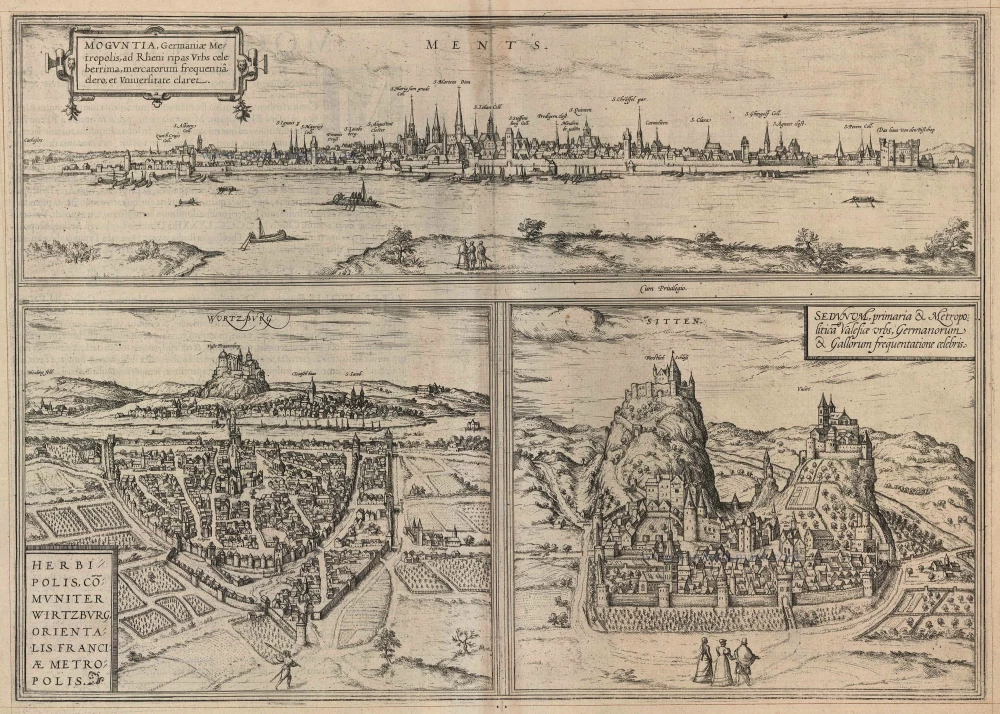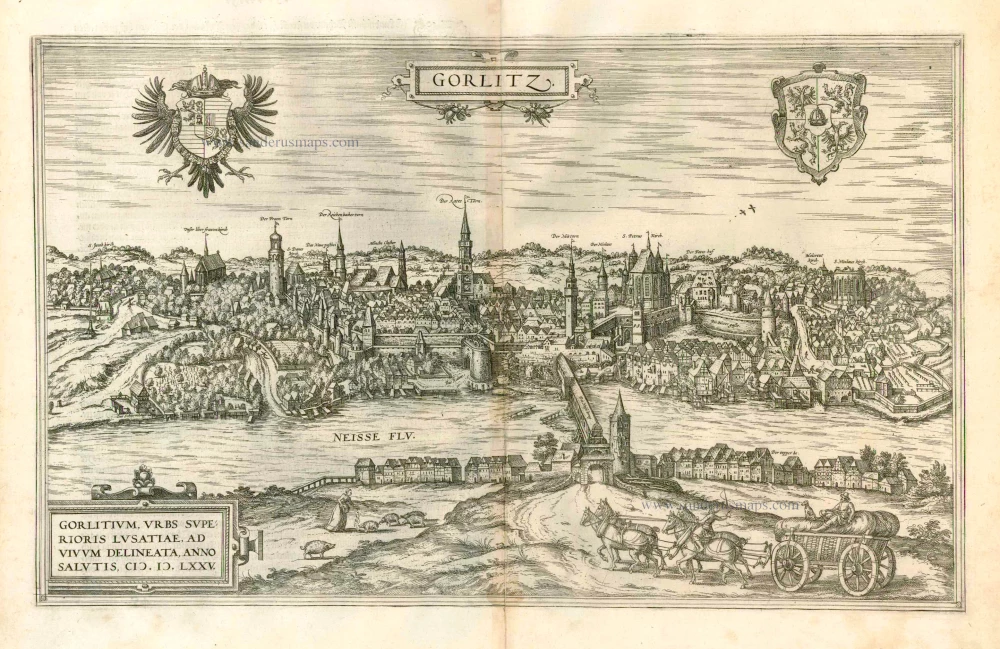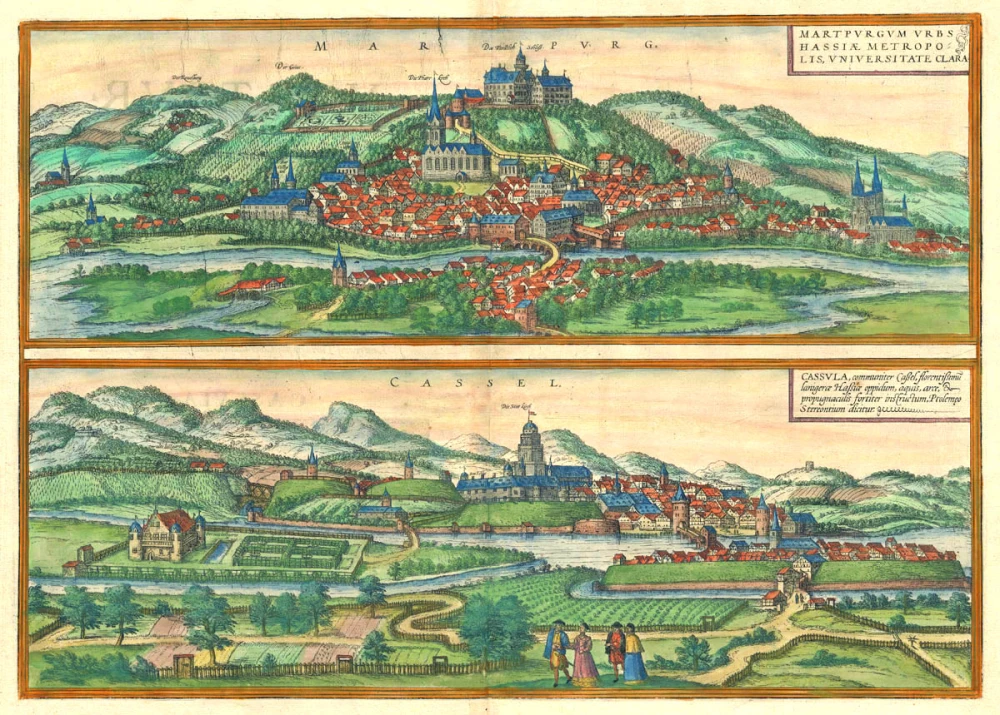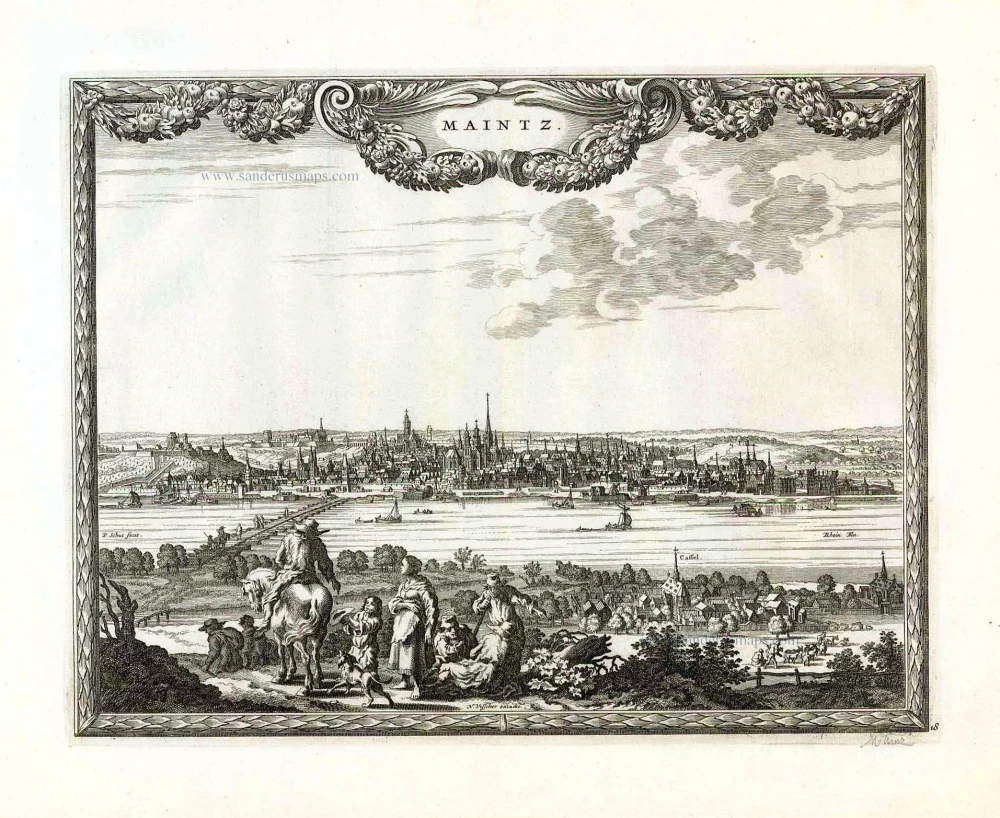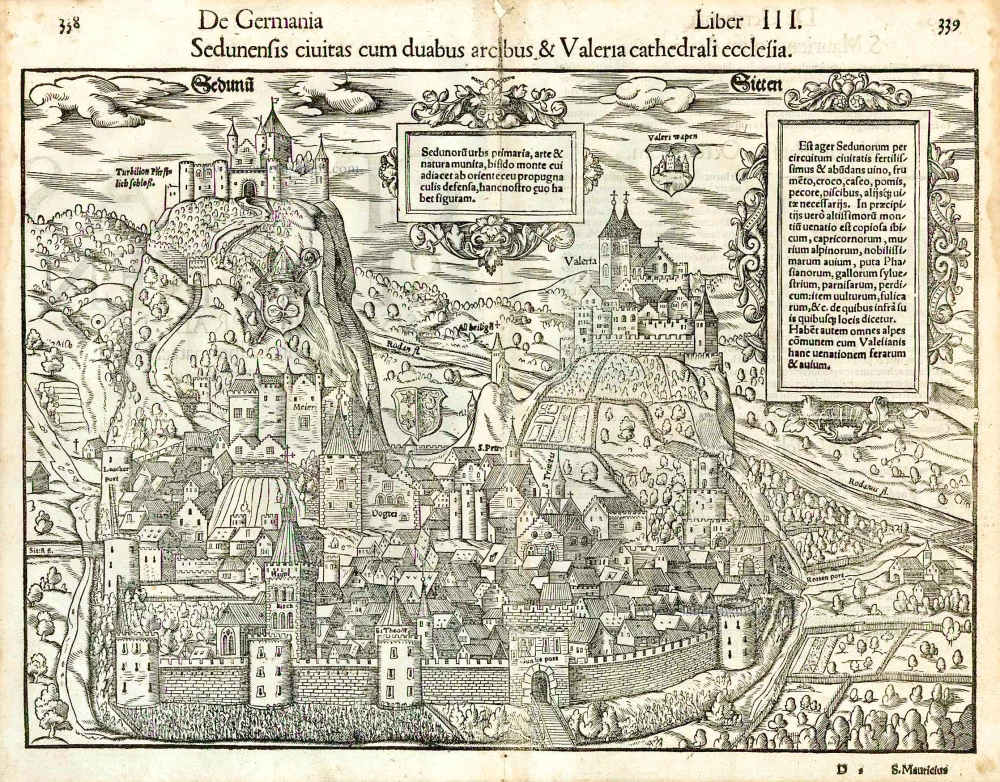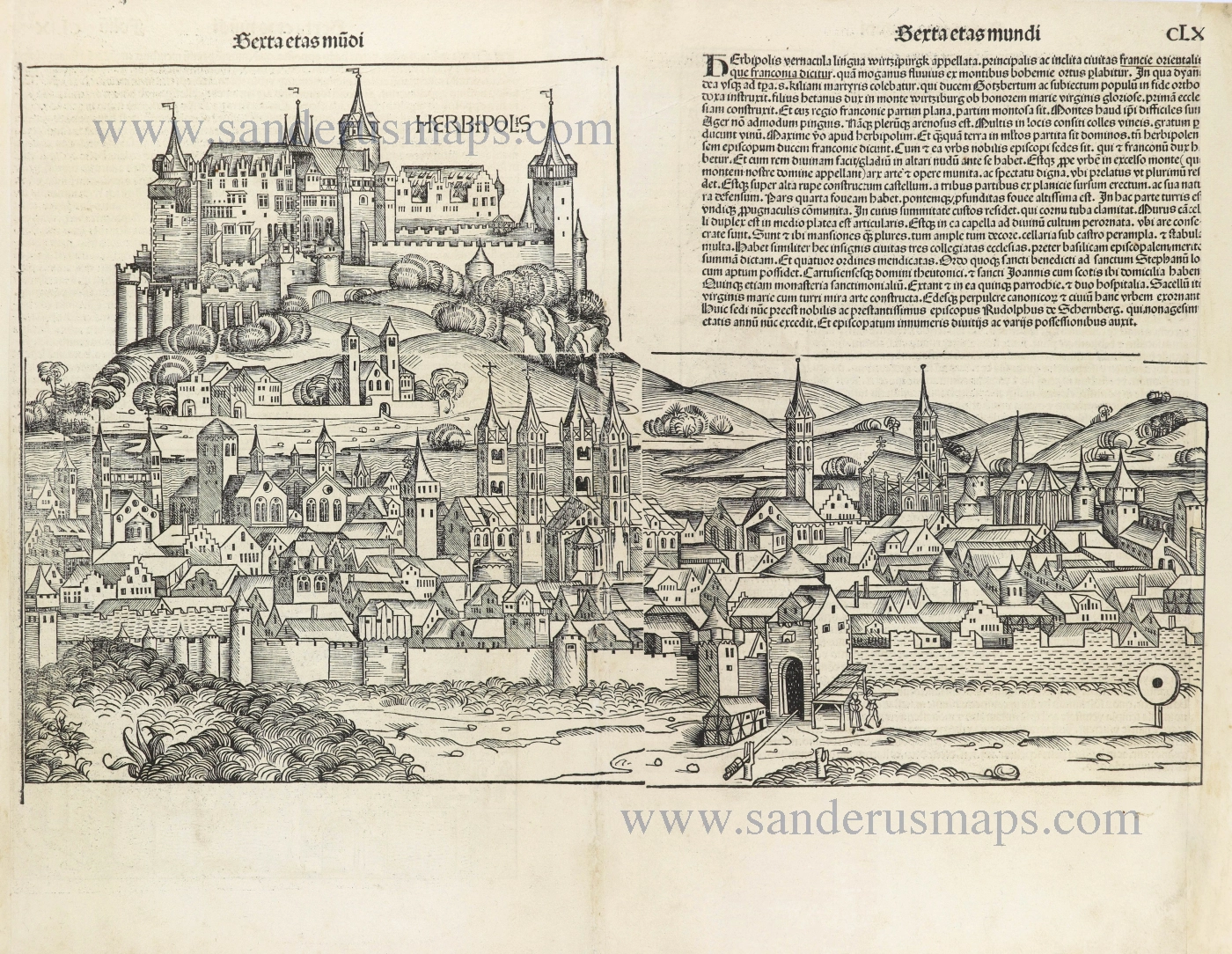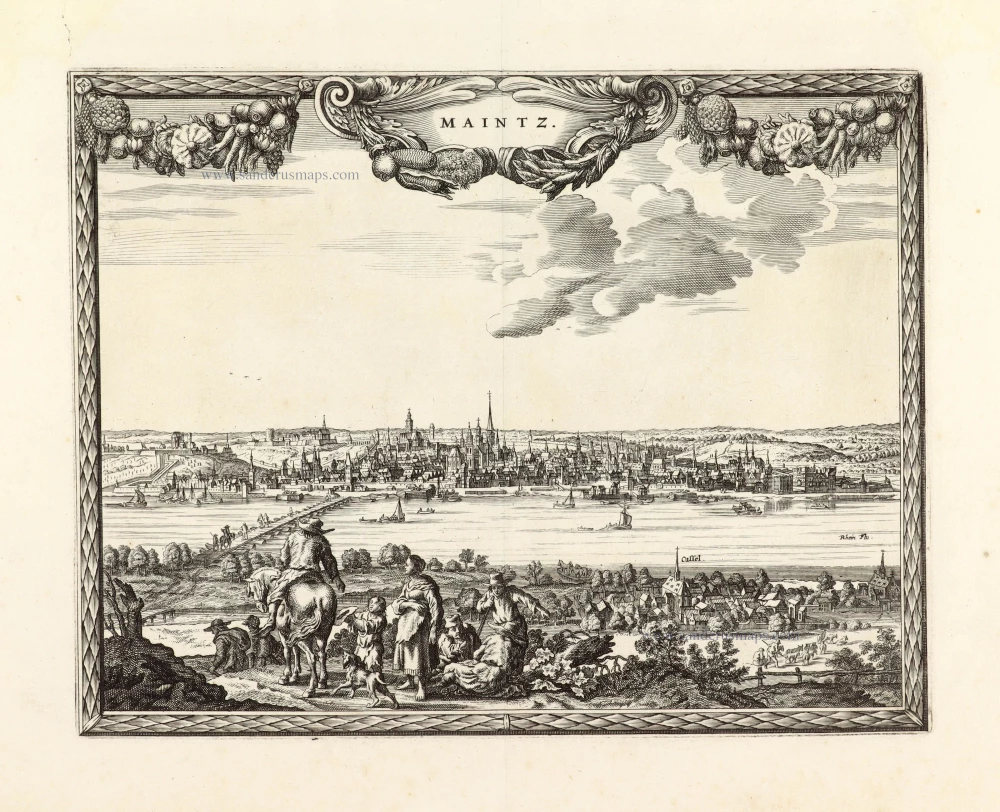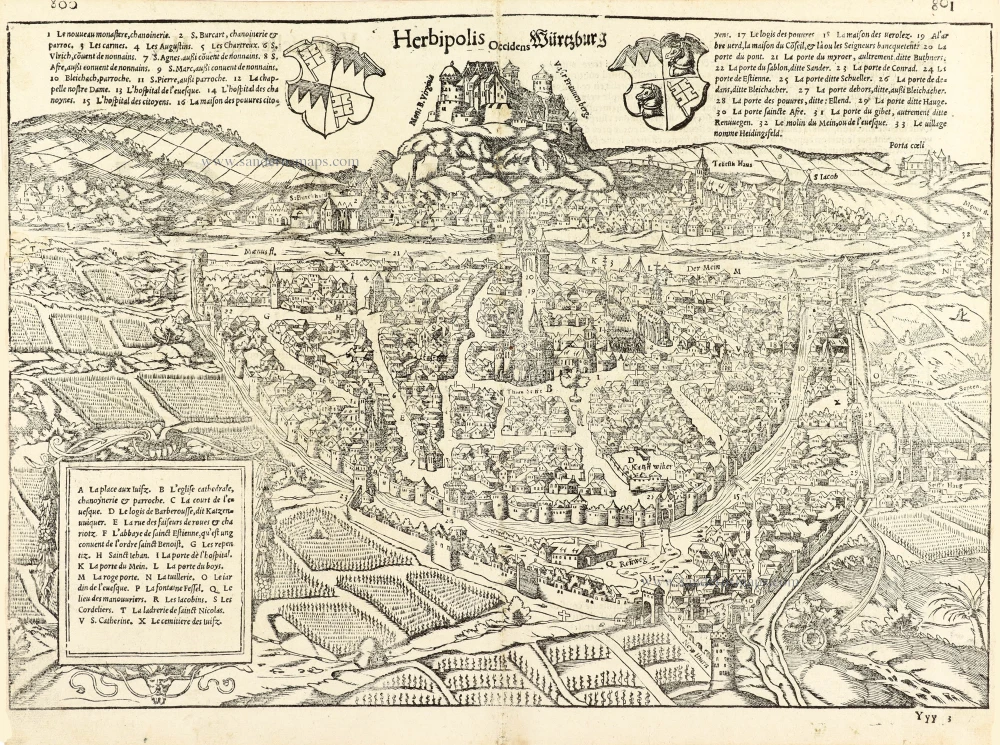Mainz, Würzburg and Sion (Sitten), by Georg Braun and Frans Hogenberg. 1575
MAINZ
TRANSLATION OF CARTOUCHE TEXT: Mainz, a German capital, is highly famed and lies on the banks of the Rhine; it is renowned for its many merchants, its clergy and its university.
COMMENTARY BY BRAUN: "Mainz is one of the noblest capitals in the land of Germany; it lies in a favourable location where the Main, arriving from Franconia, meets the Rhine from the uplands. On both sides of the Rhine there is fertile land and delicious good wine. There is no other city on the River Rhine with more antiquities than Mainz. The city lies under the authority of the archbishop, who is also one of the seven Electors. Mainz also has a university, which was founded by Diether von Isenburg in 1477. ... The art of printing was invented here, but one might dispute whether this has produced more good or bad."
The view of Mainz is seen from the Mainspitze, one of the loviest spots at the confluence of the Main and the Rhine. The city skyline is dominated by towers and steeples. Mainz's important Roman heritage from its 2,000-year-old past as Mogontiacum, a Roman legionary base, is not illustrated; instead we are shown the well-fortified city wall, whose towers - which include the Holzturm, Fischturm and Eisenturm fronting the Rhine - establish an intresting architectural contrast with the church spires. Lying close together in the city centre are the Liebfrauenkirche, the Romanesque St Martin's cathedral and to its right St John's church. Beside the Rhine on the far right is the bishop's house, or Martinsburg.
WÜRZBURG
CARTOUCHE: Herbipolis, commonly known as Würzburg, capital of East Franconia.
COMMENTARY BY BRAUN: "Würzburg is the capital of East Franconia and takes its name from the sweet grapes yielded by the surrounding fields. This city lies on a plain but is surrounded on all sides by hills, vineyards, gardens and meadows. The city is very well furnished both with sacred and with secular buildings and has a large number of inhabitants."
Würzburg is seen in cavalier perspective and is depicted so accurately that the streets of the present-day Old Town can be recognized without difficulty. The district on the far side of the Main is seen in side view. Würzburg's most famous landmark is the Marienberg fortress (Unser Frawenberg) on the hill of the same name, which served as the residence of the prince-bishops from 1253 to 1720. In a straight line below the old Main bridge is the Romanesque St Kilian's cathedral (Thum stifft), to the right of which is the Neumünster with its two choirs, and diagonally above the Gothic St Mary's chapel (Unser Frawyn Kapel) on Unterer Markt square. In the 16th century Würzburg formed a major commercial hub within the Main-Franconia region. It is clear from both Braun's text and the engraving that the city's most important export was wine.
SION (SITTEN)
CARTOUCHE: Sion, first city and capital of the Valais, is famous owing to the frequent visits it is paid by the Germans and French.
COMMENTARY BY BRAUN: "The hill on the right-hand side, with the Rhà´ne running past it, is called Valeria; it was formerly a fortress, but is now an episcopal collegiate church. The bishop's seat is on the left-hand hill, on whose summit stands a handsome and well-fortified castle, where the prince and his court take up residence when the lower palace becomes too hot. The countryside around Sion is extremely fertile and produces wine, saffron, cheese and other necessities of life."
The view of Sion is incorrectly drawn in terms of perspective. The skyline is dominated by the two mountains with the castles of Majoria and Valeria. On the right-hand summit lies the basilica of Notre-Dame-de-Valà¨re, which houses the oldest playable organ in the world, dating from the 15th century. As Braun notes, the highly valuable spice saffron was cultivated in the region around Sion in the Valais. The city's history was shaped by the bishopric that was founded here in the 6th century AD and by Sion's position as capital of the Swiss canton of Valais. (Taschen)
The three views are engraved after a views in Münster's Cosmographia, 1550.
Braun G. & Hogenberg F. and the Civitates Orbis Terrarum.
The Civitates Orbis Terrarum, also known as the 'Braun & Hogenberg', is a six-volume town atlas and the most excellent book of town views and plans ever published: 363 engravings, sometimes beautifully coloured. It was one of the best-selling works in the last quarter of the 16th century. Georg Braun, a skilled writer, wrote the text accompanying the plans and views on the verso. Many plates were engraved after the original drawings of a professional artist, Joris Hoefnagel (1542-1600). The first volume was published in Latin in 1572 and the sixth in 1617. Frans Hogenberg, a talented engraver, created the tables for volumes I through IV, and Simon van den Neuwel made those for volumes V and VI. Other contributors were cartographers Daniel Freese and Heinrich Rantzau, who provided valuable geographical information. Works by Jacob van Deventer, Sebastian Münster, and Johannes Stumpf were also used as references. Translations appeared in German and French, making the atlas accessible to a broader audience.
Since its original publication of volume 1 in 1572, the Civitates Orbis Terrarum has left an indelible mark on the history of cartography. Seven more editions followed the first volume in 1575, 1577, 1582, 1588, 1593, 1599, and 1612. Vol.2, initially released in 1575, saw subsequent editions in 1597 and 1612. The subsequent volumes, each a treasure trove of historical insights, graced the world in 1581, 1588, 1593, 1599, and 1606. The German translation of the first volume, a testament to its widespread appeal, debuted in 1574, followed by the French edition in 1575.
Several printers were involved: Theodor Graminaeus, Heinrich von Aich, Gottfried von Kempen, Johannis Sinniger, Bertram Buchholtz, and Peter von Brachel, all of whom worked in Cologne.
Georg Braun (1541-1622)
Georg Braun, the author of the text accompanying the plans and views in the Civitates Orbis Terrarum, was born in Cologne in 1541. After his studies in Cologne, he entered the Jesuit Order as a novice, indicating his commitment to learning and intellectual pursuits. In 1561, he obtained his bachelor's degree; in 1562, he received his Magister Artium, further demonstrating his academic achievements. Although he left the Jesuit Order, he continued his studies in theology, gaining a licentiate in theology. His theological background likely influenced the content and tone of the text in the Civitates Orbis Terrarum, adding a unique perspective to the work.
Frans Hogenberg (1535-1590)
Frans Hogenberg was a Flemish and German painter, engraver, and mapmaker. He was born in Mechelen as the son of Nicolaas Hogenberg.
By the end of the 1560s, Frans Hogenberg was employed upon Abraham Ortelius's Theatrum Orbis Terrarum, published in 1570; he is named an engraver of numerous maps. In 1568, he was banned from Antwerp by the Duke of Alva and travelled to London, where he stayed a few years before emigrating to Cologne. He immediately embarked on his two most important works, the Civitates, published in 1572 and the Geschichtsblätter, which appeared in several series from 1569 until about 1587.
Thanks to large-scale projects like the Geschichtsblätter and the Civitates, Hogenberg's social circumstances improved with each passing year. He died as a wealthy man in Cologne in 1590.
Moguntia, Germaniae Metropolis, ... [on sheet with] Herbipolis, comuniter Wirtzburg, ... [and] Sedunum, primaria & Metropolitica ...
Item Number: 6343 Authenticity Guarantee
Category: Antique maps > Europe > Germany - Cities
Old, antique views of Mainz, Würzburg and Sion (Sitten), by Georg Braun and Frans Hogenberg.
Title: Moguntia, Germaniae Metropolis, ... [on sheet with] Herbipolis, comuniter Wirtzburg, ... [and] Sedunum, primaria & Metropolitica ...
Date of the first edition: 1572.
Date of this map: 1575.
Copper engraving, printed on paper.
Size (not including margins): 335 x 470mm (13.19 x 18.5 inches).
Verso: Latin text.
Condition: Uncoloured, some browning along upper centrefold.
Condition Rating: A.
From: Civitates Orbis Terrarum, Liber Primus. Antwerp, Gilles van den Rade, 1575. (Van der Krogt 4, 41:1.1)
MAINZ
TRANSLATION OF CARTOUCHE TEXT: Mainz, a German capital, is highly famed and lies on the banks of the Rhine; it is renowned for its many merchants, its clergy and its university.
COMMENTARY BY BRAUN: "Mainz is one of the noblest capitals in the land of Germany; it lies in a favourable location where the Main, arriving from Franconia, meets the Rhine from the uplands. On both sides of the Rhine there is fertile land and delicious good wine. There is no other city on the River Rhine with more antiquities than Mainz. The city lies under the authority of the archbishop, who is also one of the seven Electors. Mainz also has a university, which was founded by Diether von Isenburg in 1477. ... The art of printing was invented here, but one might dispute whether this has produced more good or bad."
The view of Mainz is seen from the Mainspitze, one of the loviest spots at the confluence of the Main and the Rhine. The city skyline is dominated by towers and steeples. Mainz's important Roman heritage from its 2,000-year-old past as Mogontiacum, a Roman legionary base, is not illustrated; instead we are shown the well-fortified city wall, whose towers - which include the Holzturm, Fischturm and Eisenturm fronting the Rhine - establish an intresting architectural contrast with the church spires. Lying close together in the city centre are the Liebfrauenkirche, the Romanesque St Martin's cathedral and to its right St John's church. Beside the Rhine on the far right is the bishop's house, or Martinsburg.
WÜRZBURG
CARTOUCHE: Herbipolis, commonly known as Würzburg, capital of East Franconia.
COMMENTARY BY BRAUN: "Würzburg is the capital of East Franconia and takes its name from the sweet grapes yielded by the surrounding fields. This city lies on a plain but is surrounded on all sides by hills, vineyards, gardens and meadows. The city is very well furnished both with sacred and with secular buildings and has a large number of inhabitants."
Würzburg is seen in cavalier perspective and is depicted so accurately that the streets of the present-day Old Town can be recognized without difficulty. The district on the far side of the Main is seen in side view. Würzburg's most famous landmark is the Marienberg fortress (Unser Frawenberg) on the hill of the same name, which served as the residence of the prince-bishops from 1253 to 1720. In a straight line below the old Main bridge is the Romanesque St Kilian's cathedral (Thum stifft), to the right of which is the Neumünster with its two choirs, and diagonally above the Gothic St Mary's chapel (Unser Frawyn Kapel) on Unterer Markt square. In the 16th century Würzburg formed a major commercial hub within the Main-Franconia region. It is clear from both Braun's text and the engraving that the city's most important export was wine.
SION (SITTEN)
CARTOUCHE: Sion, first city and capital of the Valais, is famous owing to the frequent visits it is paid by the Germans and French.
COMMENTARY BY BRAUN: "The hill on the right-hand side, with the Rhà´ne running past it, is called Valeria; it was formerly a fortress, but is now an episcopal collegiate church. The bishop's seat is on the left-hand hill, on whose summit stands a handsome and well-fortified castle, where the prince and his court take up residence when the lower palace becomes too hot. The countryside around Sion is extremely fertile and produces wine, saffron, cheese and other necessities of life."
The view of Sion is incorrectly drawn in terms of perspective. The skyline is dominated by the two mountains with the castles of Majoria and Valeria. On the right-hand summit lies the basilica of Notre-Dame-de-Valà¨re, which houses the oldest playable organ in the world, dating from the 15th century. As Braun notes, the highly valuable spice saffron was cultivated in the region around Sion in the Valais. The city's history was shaped by the bishopric that was founded here in the 6th century AD and by Sion's position as capital of the Swiss canton of Valais. (Taschen)
The three views are engraved after a views in Münster's Cosmographia, 1550.
Braun G. & Hogenberg F. and the Civitates Orbis Terrarum.
The Civitates Orbis Terrarum, also known as the 'Braun & Hogenberg', is a six-volume town atlas and the most excellent book of town views and plans ever published: 363 engravings, sometimes beautifully coloured. It was one of the best-selling works in the last quarter of the 16th century. Georg Braun, a skilled writer, wrote the text accompanying the plans and views on the verso. Many plates were engraved after the original drawings of a professional artist, Joris Hoefnagel (1542-1600). The first volume was published in Latin in 1572 and the sixth in 1617. Frans Hogenberg, a talented engraver, created the tables for volumes I through IV, and Simon van den Neuwel made those for volumes V and VI. Other contributors were cartographers Daniel Freese and Heinrich Rantzau, who provided valuable geographical information. Works by Jacob van Deventer, Sebastian Münster, and Johannes Stumpf were also used as references. Translations appeared in German and French, making the atlas accessible to a broader audience.
Since its original publication of volume 1 in 1572, the Civitates Orbis Terrarum has left an indelible mark on the history of cartography. Seven more editions followed the first volume in 1575, 1577, 1582, 1588, 1593, 1599, and 1612. Vol.2, initially released in 1575, saw subsequent editions in 1597 and 1612. The subsequent volumes, each a treasure trove of historical insights, graced the world in 1581, 1588, 1593, 1599, and 1606. The German translation of the first volume, a testament to its widespread appeal, debuted in 1574, followed by the French edition in 1575.
Several printers were involved: Theodor Graminaeus, Heinrich von Aich, Gottfried von Kempen, Johannis Sinniger, Bertram Buchholtz, and Peter von Brachel, all of whom worked in Cologne.
Georg Braun (1541-1622)
Georg Braun, the author of the text accompanying the plans and views in the Civitates Orbis Terrarum, was born in Cologne in 1541. After his studies in Cologne, he entered the Jesuit Order as a novice, indicating his commitment to learning and intellectual pursuits. In 1561, he obtained his bachelor's degree; in 1562, he received his Magister Artium, further demonstrating his academic achievements. Although he left the Jesuit Order, he continued his studies in theology, gaining a licentiate in theology. His theological background likely influenced the content and tone of the text in the Civitates Orbis Terrarum, adding a unique perspective to the work.
Frans Hogenberg (1535-1590)
Frans Hogenberg was a Flemish and German painter, engraver, and mapmaker. He was born in Mechelen as the son of Nicolaas Hogenberg.
By the end of the 1560s, Frans Hogenberg was employed upon Abraham Ortelius's Theatrum Orbis Terrarum, published in 1570; he is named an engraver of numerous maps. In 1568, he was banned from Antwerp by the Duke of Alva and travelled to London, where he stayed a few years before emigrating to Cologne. He immediately embarked on his two most important works, the Civitates, published in 1572 and the Geschichtsblätter, which appeared in several series from 1569 until about 1587.
Thanks to large-scale projects like the Geschichtsblätter and the Civitates, Hogenberg's social circumstances improved with each passing year. He died as a wealthy man in Cologne in 1590.

